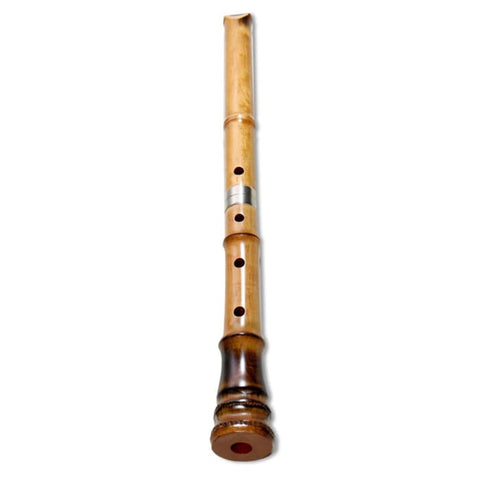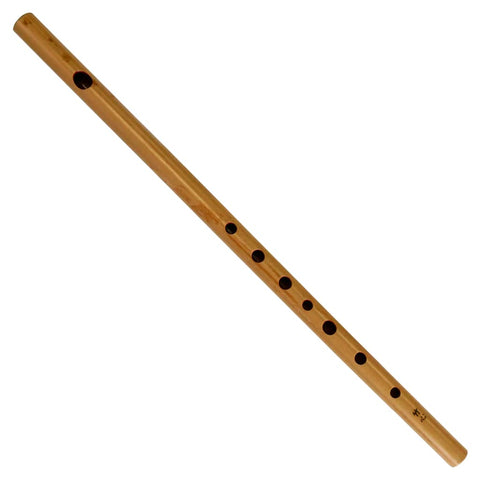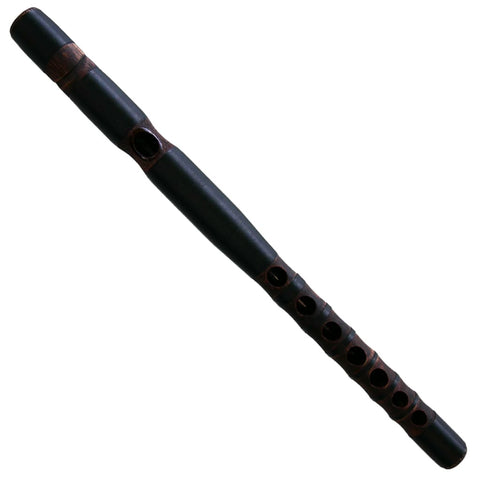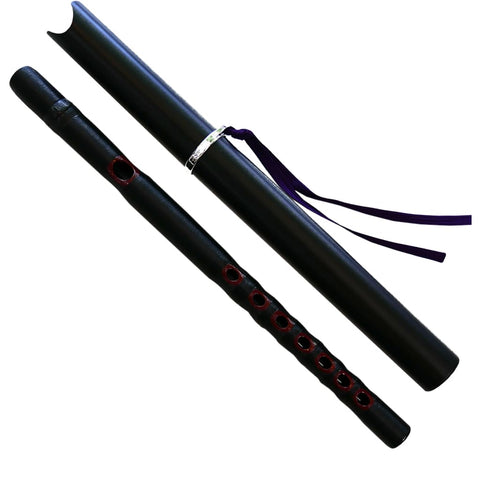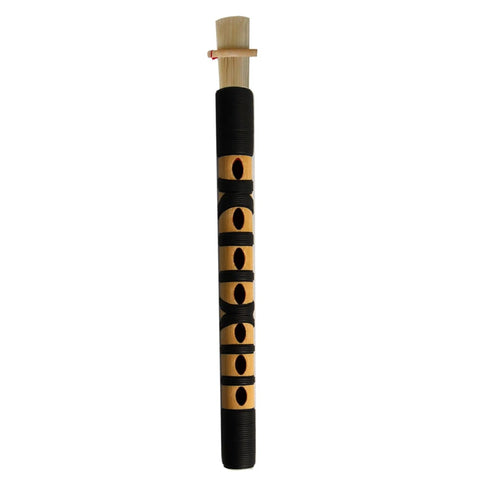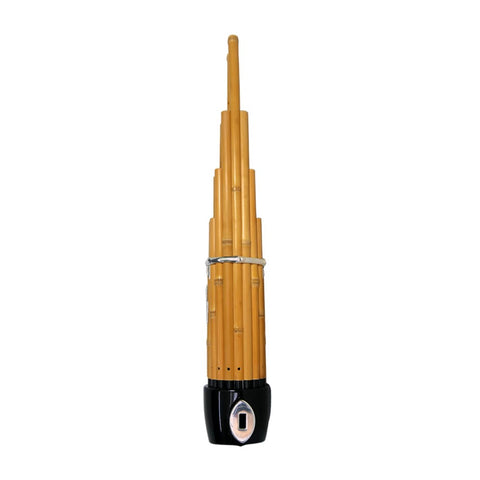6 Types of Traditional Japanese Flute (Fue) and How to Play
Fue -Traditional Japanese Flute-
"Fue" is the general terms for flute in Japanese. In this post, we explain how to play the "fue (traditional Japanese flutes)". Nowadays, western music is familiar to Japanese people but the sound of the "fue" is still familiar to Japanese, too. For example, the sound of "shakuhachi (a Japanese end-blown flute)" makes us relaxed and the sound of "shinobue (one of the Japanese transverse flutes)" reminds us of our local festivals. In addition, we often hear the sound of "gagaku (Japanese court music)" at shrine on new years day and traditional-style wedding ceremony in Japan. "Hichiriki (a Japanese double-reed instrument)" and "ryuteki (one of the Japanese transverse flutes)" are in charge of the melody part and play in harmony with "sho (a Japanese mouth organ)" in "gagaku". Furthermore, nohkan (one of the Japanese transverse flutes) is played in the "noh play (one of the traditional Japanese performing arts)". The scale of "nohkan" is much different from the western scale and even the scale of each instrument is different to produce the ultimate sound and make the "noh play" excellent. Unlike the western flute made of metal, most Japanese flute is made of wood (bamboo) as it was before. Let's try these traditional Japanese flutes and create your new music & arts!
|
|
1. Shakuhachi
Shakuhachi is one of the most popular Japanese instruments as well as shamisen (Japanese lute), koto (Japanese harp), and taiko (Japanese drum). There are a lot of shakuhachi artists around the world and the number of the player will further increase due to the reasonable and high quality plastic shakuhachi, shakuhachi yuu, which is popular among beginners. It sounds like the sound of the natural environment like wind and forest. The pitch range is approximately two and a half octaves but the possibility of the musical expression is infinity.
Fingering Chart of Shakuhachi
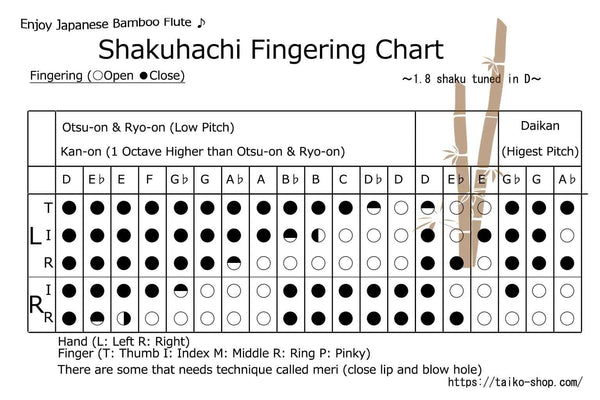
How to Play the Shakuhachi
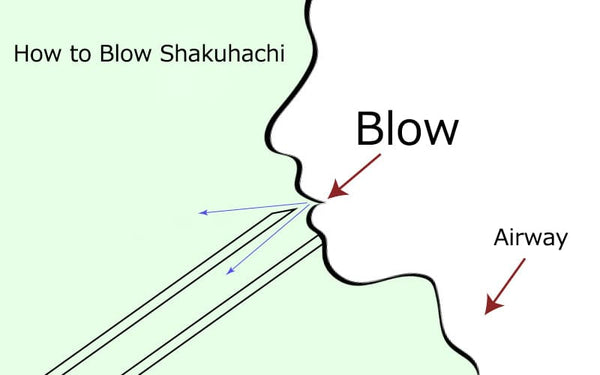
Hold shakuhachi with right hand on lower holes (2 holes on the front) and left hand on upper holes (2 holes on the front and 1 hole on the back). Place the edge part of the blow hole between the lower lip and chin. Blow air to the opposite side of the blow hole edge. To play 1 octave higher sound, blow sharp and fast air and narrow your airway as you sing high notes.
2. Shinobue
Shinobue is often played in Japanese festivals and becoming popular among taiko players in these days. Taiko (taiko drum), fue (shinobue flute), and kane (gong or cymbals) are often played in Japanese festivals and the sound of shinobue is familiar to Japanese as a memory of festival. It becomes popular among taiko players as a melodic instrument and solo in the taiko performance. The structure is so simple but the range is very wide from low pitch to higher pitch (approximately two and a half octaves). The sound produced is very warm and relaxing.
Fingering Chart of Shinobue

How to Play the Shinobue
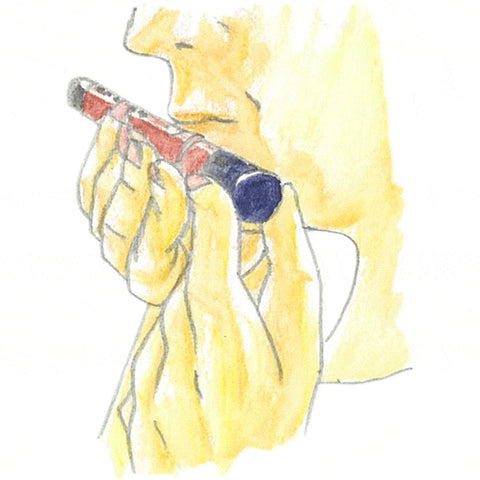
Hold shinobue horizontally on the right side of the player. Place the index finger, the middle finger, and the ring finger of the left hand on the nearest three finger holes and the index finger, the middle finger, the ring finger, and the little finger of the right hand on the remaining four finger holes. Make the center of the blow hole in the center of the face and cover one third of the blow hole with the lower lip. Then, hit the air to the edge of the blow hole and find the best place to hit the air by turning shinobue outwards or inwards. If you catch how to blow shinobue, you will be able to play other Japanese flute, too.
Related Articles
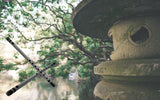 |
Do you know types of shinobue? See also this article. Types of Shinobue |
 |
Want to know how to play shinobue? See also this article. Fingering Chart of Shinobue |
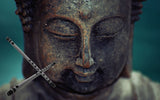 |
Want to know embouchure? See also this article. Embouchure and Finger Placement of Shinobue |
3. Ryuteki
Ryuteki is one of the three major wind instruments for gagaku (traditional Japanese court music). To translate the name directly, it means "dragon flute" in Japanese. As its name suggests, it sounds like cry of the dragon flying through the sky. In the gagaku music, ryuteki is often played for the type of the tohgaku music. On the other hand, komabue flute is played for the type of the komagaku music and kagurabue flute is played for the type of the mikagura music. These instruments look similar but the sound, the shape, and types of music are different. It has a lead inside and bindings are wound around whole part. So, compared to shinobue flute, it is a little heavier and looks luxurious. The sound produced is clear and loud. The pitch range is about 2 octaves.
Fingering Chart of Ryuteki
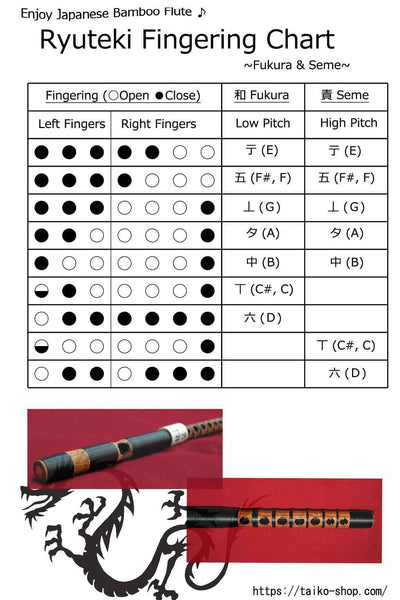
How to Play the Ryuteki
Hold ryuteki horizontally on the right side of the player as well as shinobue. Placing fingers and lips are just like shinobue, too. But, it needs to blow a little wider and cover blow hole a little wider with the lower lip compared to shinobue because it has a bigger blow hole and finger holes.
4. Nohkan
Nohkan is a flute played with drums (taiko & tsuzumi) for the noh play, one of the traditional Japanese performing arts. As well as ryuteki flute, it has a lead inside and bindings are wound around whole part. In addition, blow hole and finger holes are painted and it has a metal ornament on the top. Also, it has a small tube called "nodo", which combines with the body. Due to this part, nohkan produces the unique high pitched sound.
Fingering Chart of Nohkan
There is no fingering chart for nohkan. The scale of "nohkan" is much different from the western scale and even the scale of each instrument is different. Unlike the "ryuteki" flute which was introduced from the continent, "nohkan" has been developed in Japan. So, you could say that the sound of nohkan suits with the sense of Japanese.
How to Play the Nohkan
Hold nohkan horizontally on the right side of the player as well as shinobue and ryuteki. Placing fingers and lips are just like ryuteki. But, it needs more speedy blow. As noted above, there's no finger chart for this instrument and the sounds played are different according to the player and school.
5. Hichiriki
Hichiriki is a Japanese double reed instrument like the oboe. As well as ryuteki flute, hichiriki is one of the three major wind instruments for gagaku (traditional Japanese court music). It has a body part made of bamboo and a reed made of reed around the body. It has 9 holes (7 holes on the front and 2 holes on the back) and rattan bindings. Before playing the hichiriki, the reed needs to be open a little bit by soaking warm water (green tea is better). Meaning of the hichiriki in the gagaku music is voice of people (ground). Although it has only 18cm (about 7in), the sound is very loud and unique. It has only 1 octave but plays melody with various tone.
Fingering Chart of Hichiriki
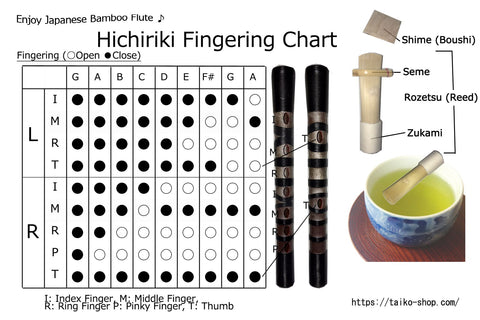
How to Play the Hichiriki
First, open the blow hole of the rozetsu (reed) by putting it into the warm water. Remove shime (boushi) and seme from the rozetsu. Soak it into the warm water (green tea is better) to open the blow hole 1mm to 1.5mm (about 0.04in to 0.06in). Wipe off the water from rozetsu. Then, insert it into the body part of the hichiriki (red string should be right side to the player). Hold hichiriki vertically. Place the left index finger, the middle finger, and the ring finger on the upper three finger holes on the front and left thumb on the upper one finger hole on the back. Place the right index finger, the middle finger, the ring finger, and the little finger on the lower 4 finger holes and right thumb in the lower one finger hole on the back. Put the reed in the mouth up to seme part (this part should be out of mouth). Relax the lip and blow it as same as blowing up a balloon. It may need a lot of practice to make a sound. It's better to practice 10 minutes every single day rather than practice 1 hour once a week. Take it easy.
6. Sho (Hosho)
Sho is a Japanese mouth organ and one of the three major wind instruments for gagaku (traditional Japanese court music) as well as ryuteki and hichiriki. It has 17 bamboo sticks put on the base. The shape looks like "houou (a legendary bird)" resting with folding wings. So, it's also called the beautiful name, "hosho". In the gagaku music, it represents the voice from the sky. 15 bamboo sticks make the sound and it mainly plays sho's 10 (or 11) chords.
Fingering Chart of Sho (Hosho)
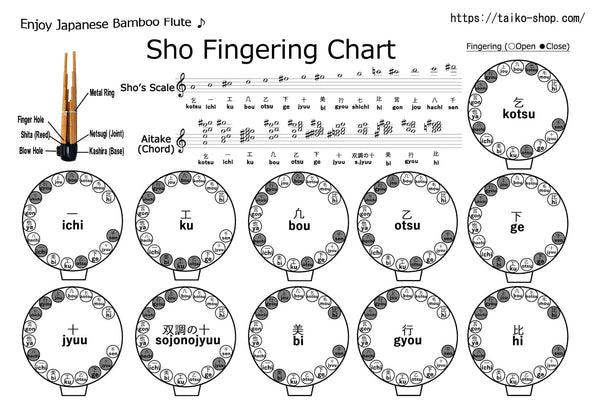
How to Play the Sho (Hosho)
Before and after playing the sho flute, it needs to be warmed up by a heater so that the reed is hard to make a sound if it's wet. It prevents the reed from the condensation due to the difference of the temperature and humidity. Please note that the beeswax melts if it is heated too much. Hold kashira (base) with one hand and bamboo sticks with another hand. Turn it round and round over the heater to warm the whole part evenly. Straighten yourself and hold the kashira with both hands to make your fingers move freely. Blow and draw in the air while you close the finger holes and make chords of sho.
Related Articles
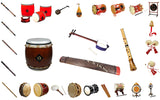 |
Let's learn other Japanese instruments, too. Guide to 33 Types of Traditional Japanese Instruments |
😚Thank you for reading this to the end. Please feel free to ask any questions or leave any comments😉


